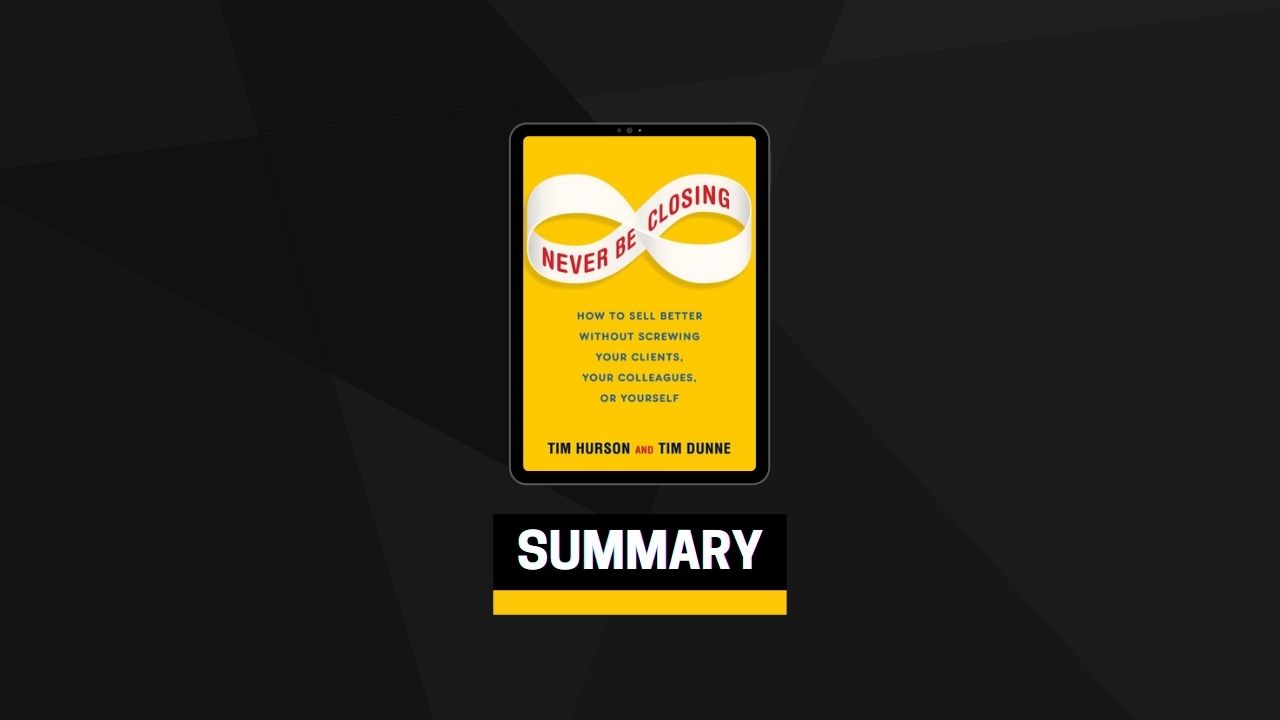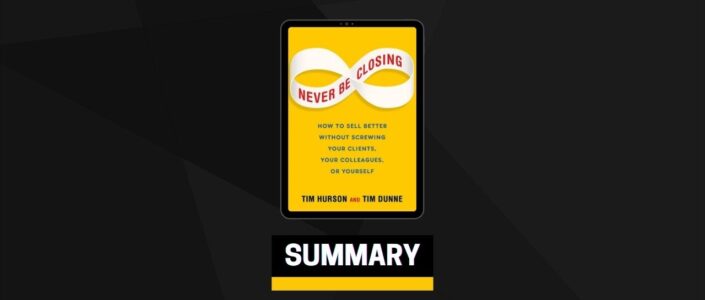Think About It—Think Better to Sell Better
Perhaps the overriding parallel between thinking and selling is that many people think success in both these activities is primarily a function of natural talent—that good thinkers are simply blessed with good brains, and that good salespeople were just born to sell. There’s some truth to both those assertions. Yes, people do have varying levels of creative intelligence, which helps them think more creatively, just as some people have varying levels of social and emotional intelligence, which may help them sell better.
But raw talent is only part of the equation. By applying a set of straightforward tools and techniques, by practicing, and by paying attention to feedback, anyone can learn to sell better. In other words, by taking a structured approach to selling, you can leverage whatever natural talent you have and multiply the quality of your output—just as a naturally gifted athlete gets better by learning new skills, practicing them, and adjusting to game situations.
And that’s as true for the experienced professional as it is for the novice. No matter how good you are now, you can get better—by acquiring new skills, by practicing, and by extracting meaningful lessons from your experiences.
Setting Your Moral Compass
Here’s a distillation of how the most productive salespeople regard their three stars:
Business. Money is important. It provides me and my family with security, safety, and varying degrees of comfort. Money allows me to invest in things that support my values. But money is not a scorecard.
Relationships. To the extent possible, I work with people I like and select clients I like. I get genuine pleasure from helping them. As my relationships deepen, they provide me with increased satisfaction. I recognize that I can neither buy the friendship of others nor sell mine to them. I know I won’t necessarily like everyone and everyone won’t necessarily like me.
Challenge. I am energized by puzzles. I get intellectual and emotional satisfaction from understanding and solving complicated and sticky problems. That this makes me money is great but secondary. It bothers me if I am unable to connect with a client or create a solution that works for him or her. Solving other people’s problems gives me a buzz and I’ll scour the ends of the earth to find an answer.
The three goals above are specific to a large number of salespeople. There is no right or wrong answer. Most of us are motivated by some combination of material, relationship, and intrinsic goals.
The Power of Scripts
Think of your scripts as building blocks to help you create a strong foundation for your meeting. You can mix and match them as the need arises. You can modify them to fit your client’s circumstance and issues. You can deliver them, or you can hold them back.
The point is that simply having your scripts in your back pocket will make you more confident, more professional, and more prepared for the unexpected. With a library of well-prepared, well-rehearsed scripts, you’ll have a safety line to fall back on if things start going off the rails. Without them, you never know where you’ll land.
In a way, all the effort you put into developing, refining, and practicing your scripts is like a concert pianist practicing musical scales: you may not always use them, but you can’t play without them.
The First Yes—Get the Meeting
Ultimately, there’s no need to make cold calls. In order to ask for a meeting with a reasonable expectation you’ll get it, you need just two things: a connection and a reason. In today’s interconnected world, a connection shouldn’t be hard to find. The reason is up to you
Why might someone be willing to hear more about what you have to offer? Dozens of reasons. Here’s a starter list.
YOUR NETWORK
- You have been referred by someone relevant to your client’s work: in the best case, they’ve sent an e-mail mentioning you.
- You are part of a shared professional network: someone in your organization knows someone in theirs.
- You work with well-known companies or people (use caution—overt name-dropping can backfire).
- You have connections with people who might be useful to them.
- You know people in common outside of work.
YOUR COMPANY
- You can execute faster or better than your competitors: your product or service is demonstrably better.
- You have capabilities your client is unaware of: “One reason I want to meet you is to let you know our total range of capabilities. One of them may be useful to you.”
YOUR BUSINESS SAVVY
- You offer interesting insights on your client’s situation.
- You have relevant intelligence that relates to an initiative your client is pursuing or to industry trends.
- You are a known problem solver and innovative thinker.
- You work with your client’s competitors or companies in their supply or delivery chain.
- You have other experience in their business niche.
SERENDIPITY
- You’re going to be in your client’s neighborhood or city.
Make Research Make Sense—Find Five Questions
As you become more comfortable and practiced, you’ll know when you have enough information for a productive sales meeting. You’ll learn how to avoid overresearching and underresearching. You’ll naturally tweak and refine your information-gathering process to give you the data you need at a price (in time and effort) that you’re willing to pay. We hope you’ll take our recommendations as a starting point and design a research process that works for you.
You’ll find that once you’ve merged that process into your routine, research won’t be a separate activity anymore. It will be something you naturally integrate into almost all your activities. It will become what’s known as an unconscious competency, like riding a bike without even thinking about it.
You’ll establish a routine, perhaps every Tuesday morning over coffee, when you read the trades to keep up to date on industry trends. If you have a handful of future clients identified, your radar will be tuned to any article that mentions them or relates to a situation that impacts them. You’ll read an article about one company in your sector, and you’ll automatically flag information that may be useful for getting a meeting with another.
The Sales Conversation—a Relationship in Three Acts
Like the best films, fairy tales, and fiction, the most productive sales meetings also use a three-act structure—with a beginning, a middle, and an end.
The three acts of the sales conversation are:
I: Earning the Right to Ask
II: Exploration
III: Demonstrating Usefulness
To drive the meeting forward, the first and second acts contain turning points, just as in a drama, that signal the beginning of the next phase of the interaction.
Here’s how it works:
In Act I, you work to earn the credibility to ask probing questions. Once you cross the credibility threshold, you propel the meeting into its second act. In an hour-long meeting, Act I may last from ten to fifteen minutes.
In Act II, you explore your client’s needs by asking a series of carefully designed questions that help both you and your client better understand the issues and challenges that need to be resolved. Its turning point is the catalytic question—the question that provokes genuine interest, clears away the fog, motivates a desire to act, and opens the door to novel solutions. This turning point drives the meeting into its third act. In an hour-long meeting, Act II may last about thirty minutes.
In Act III, you demonstrate usefulness to your client by offering resources and insights, matching your client’s needs to your products or services, and establishing the basis for a continuing relationship. In an hour-long conversation, Act III may last about fifteen minutes (however, if you’re really being useful to your client, your meeting may go beyond its original end time).
Commencement—Occupy Headspace
Headspace. Have you ever noticed that for some people, recognition and success just seem to fall into their laps? Their names pop up whenever people think about certain issues or problems. They even get calls from complete strangers, out of the blue, because a mutual acquaintance recommended them. In effect, they’re successful because other people think about them. These people have mastered the art of occupying headspace.
The key is to engage with your clients just often enough that they think of you from time to time. If you’ve discovered and reinforced a shared interest or a shared community with them, they might think of you as they read their hang-gliding magazines, approach that tricky sixteenth hole on the golf course you chatted about, or think about where to send their kids to college. Because you sent them a useful article on leadership a few months ago, they might think about you the next time they address an issue with a problem employee. Because you remembered they were curious about Australian rules football and sent them a note about an upcoming TV special on it, they’ll think of you as a source of information. If you’ve simply remembered their birthday or congratulated them on the anniversary of the day they started their business (which takes no more effort than recording it in your reminder calendar), you’re no longer a stranger—even if a year has gone by since your last contact.
Occupying headspace isn’t complicated. It’s just an expression of thoughtfulness. When you do something to occupy a small piece of someone else’s headspace, the message you’re sending is that they occupy a piece of yours.


